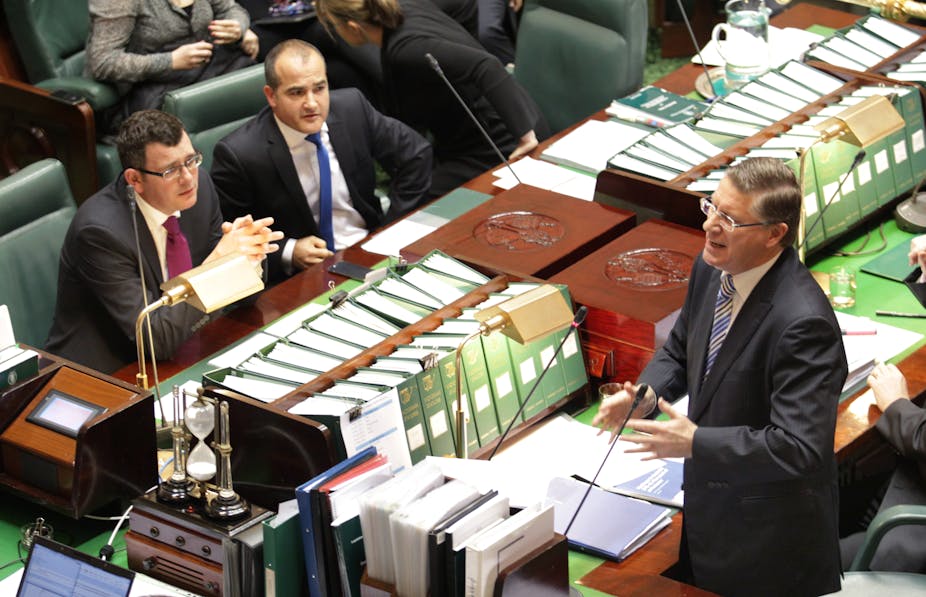It appears that there’s never been a better time to be a minor party in Australia. From a time when parliaments were the domain of only the major parties, small parties have gradually made inroads into the nations’ legislatures.
With seven weeks to go until the Victorian state election, are the new minor parties, also referred to as “micro-parties”, in a position to influence the next Victorian parliament?
The 2013 national election was the highpoint so far for such parties. A record number of new minor parties joined existing small parties represented in the Senate. These included the Liberal Democrats, Australian Motoring Enthusiast Party and the Palmer United Party. A number of Greens candidates were returned to the Senate, while Family First claimed its first seat since 2004.
Encouraged by these results, a host of minor parties are gearing up for the Victorian election on November 29.
Upper house seats are in newcomers’ sights
The prospect of winning a seat in the Victorian Legislative Assembly still appears to be beyond minor parties (though the Greens have come close in recent elections). The major parties are still expected to dominate the lower house. To be elected to the Legislative Assembly, a candidate must win at least 50%-plus one of the vote - as with the federal House of Representatives.
It’s another story in the upper house. The Legislative Council has a voting system similar to the Senate. This system provides greater opportunities for minor parties to win seats. Should they hold the balance of power, they could then exert significant influence over the new government’s legislative agenda.
Since shifting to a multi-member system using proportional representation in 2006, the Legislative Council has had a couple of minor parties win representation. The DLP won a seat in 2006, while the Greens hope to increase their numbers in the chamber this time around.
The quota needed to win a seat is about 16.7%. While higher than the quota needed for election to the Senate (which is 14.4%), minor parties can reach a quota by cobbling together a suite of deals on the flow of preference votes.
The importance of preference ‘wheeling and dealing’
Underpinning the success, or otherwise, of minor parties is the preference deals they can manufacture with other parties.
This feature gives minor parties a vital bargaining chip that can allow them to have an impact on the political debate even before a single vote is cast. Indeed, they can make deals to direct their preferences to other parties if these parties agree to advance their agenda if elected to parliament.
The group of parties that are concerned with conservative social values while opposing fertility control has been very active in this regard. For example, the Democratic Labour Party, the Australian Christians and Rise Up Australia have all decided to direct preferences to candidates who support their stance on abortion, among other policies.

In more recent elections the practice of “preference harvesting” has become a critical tool used by minor parties to claim seats. This is when minor parties make a range of preference deals with as many parties as they possibly can with the aim of constructing a flow of votes that allows them to reach the magical quota.
The Australian Motoring Enthusiast Party used this to great effect in the 2013 federal election. The MEP constructed a quota of 14.4% even though it won just 0.5% of the primary vote. Much of the credit for preference-harvesting decisions has gone to Glenn Druery, the so-called “preference whisper”.
Can minor parties replicate federal success in Victoria?
A quick glance at the party registrations on the Victorian Electoral Commission website suggests that a record number of parties will contest the poll, a situation similar to the 2013 federal election. This lends itself to preference harvesting.
The similarities between the upcoming Victorian election and the 2013 federal poll don’t end there. In both instances, the government was operating as a minority government. In Victoria, the Coalition government has been on the back foot since Geoff Shaw resigned from the Liberal Party.
Second, the government is being led by a person who did not lead them to victory in the previous election. Denis Napthine replaced Ted Baillieu in 2013.
Third, the government has appeared to be rife with internal bickering and has often been ill-disciplined. In particular, debates about moral issues and abortion have appeared to divide the Liberal Party.
Fourth, opinion polls have consistently shown the Labor opposition, led by Daniel Andrews, holds an election-winning lead.
All of these elements, in addition to the fact that so many candidates will be standing, point to a significant degree of volatility in the results. The number of minor parties from the right also suggests that they will have an impact on the Coalition’s primary vote.
In these situations micro-parties, especially from the right, would have an excellent chance of winning a seat as long as they had done their homework and constructed a suite of beneficial preference deals. Their success will also depend on where preferences from the major parties go.
The emergence of these minor parties indicates either that democracy is thriving in Victoria, or that citizens have been unimpressed with the state of politics and are more willing to vote for a new minor party. Either way, it appears that small parties are set to have a big impact on the election outcome.

